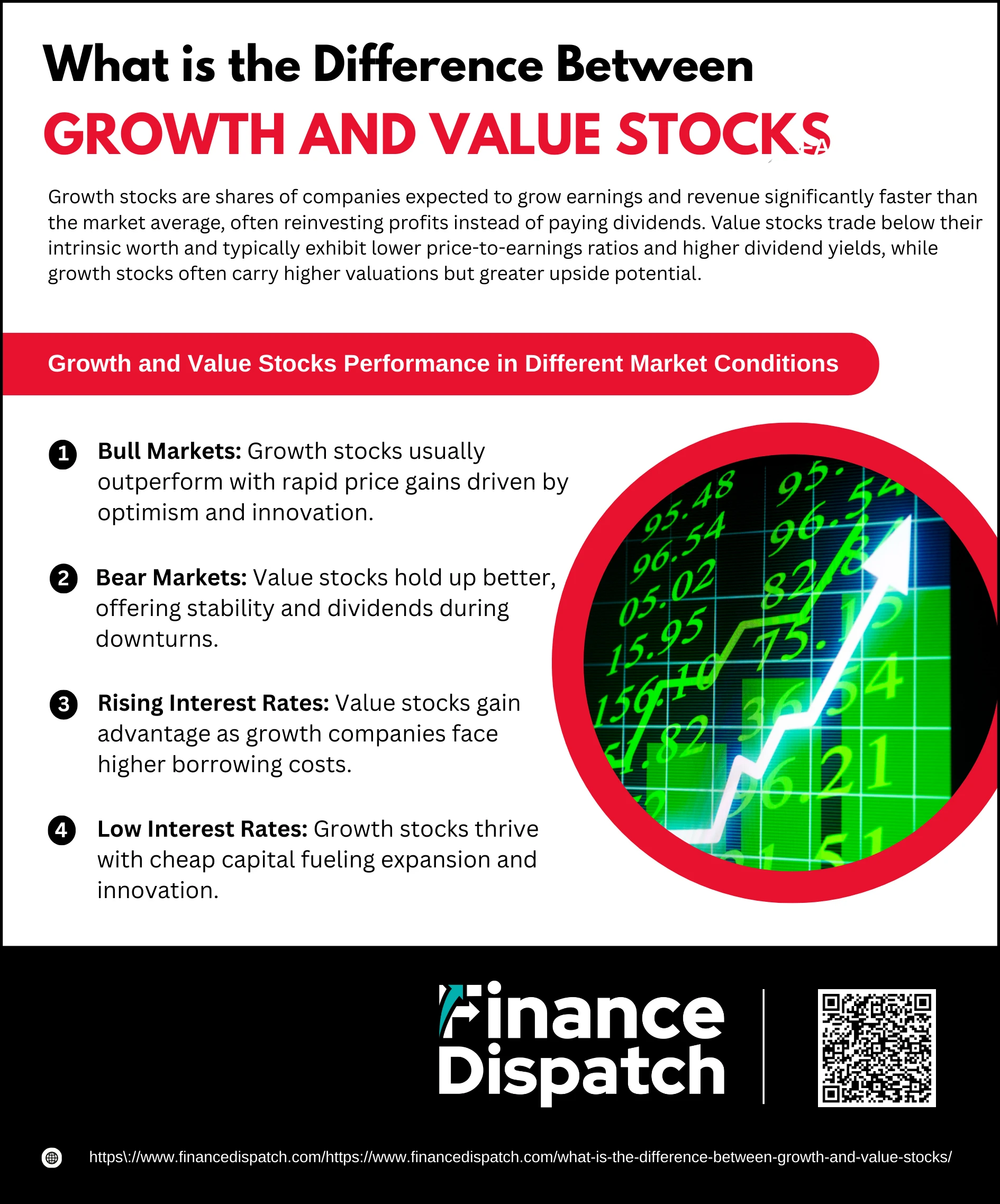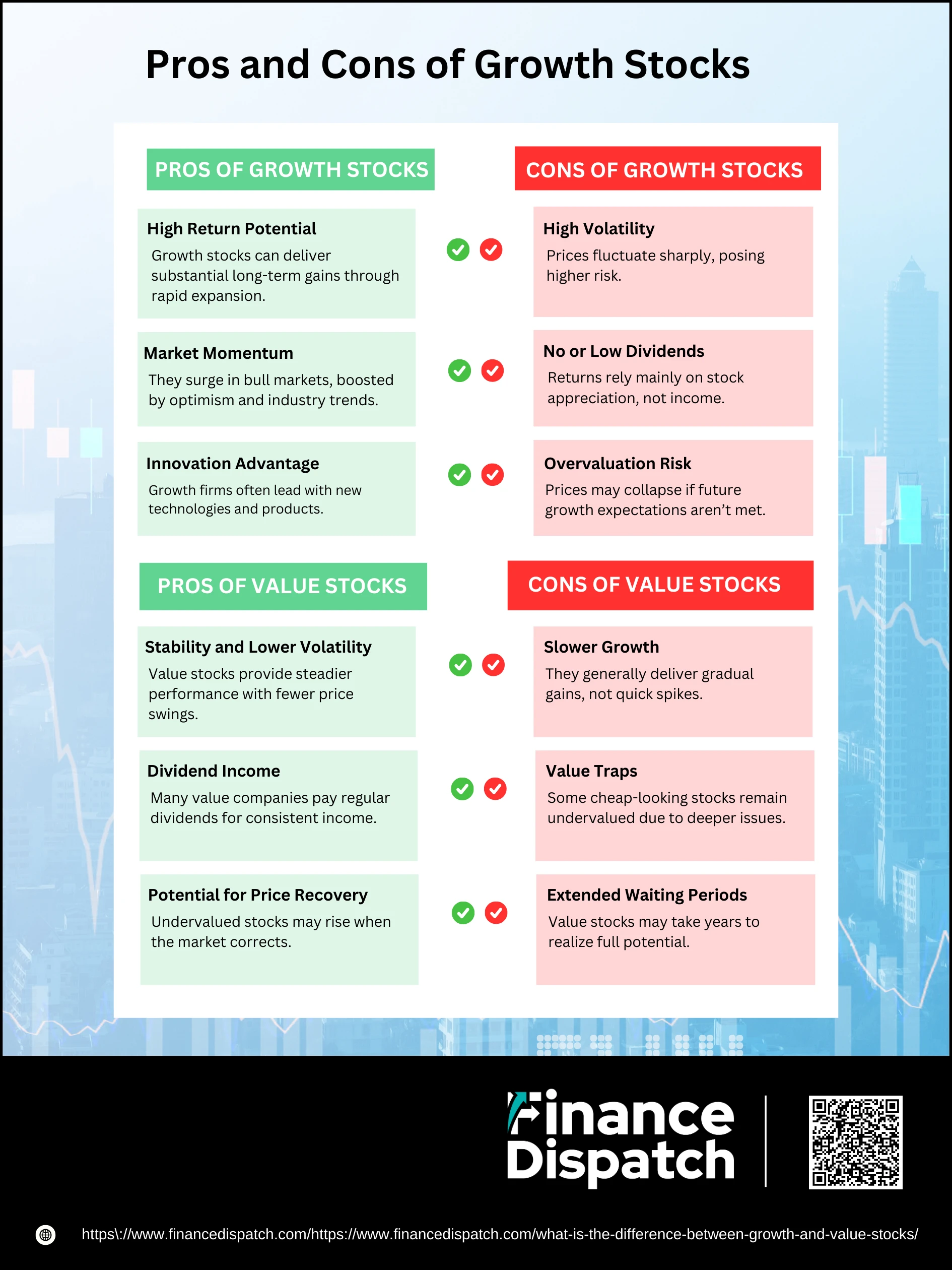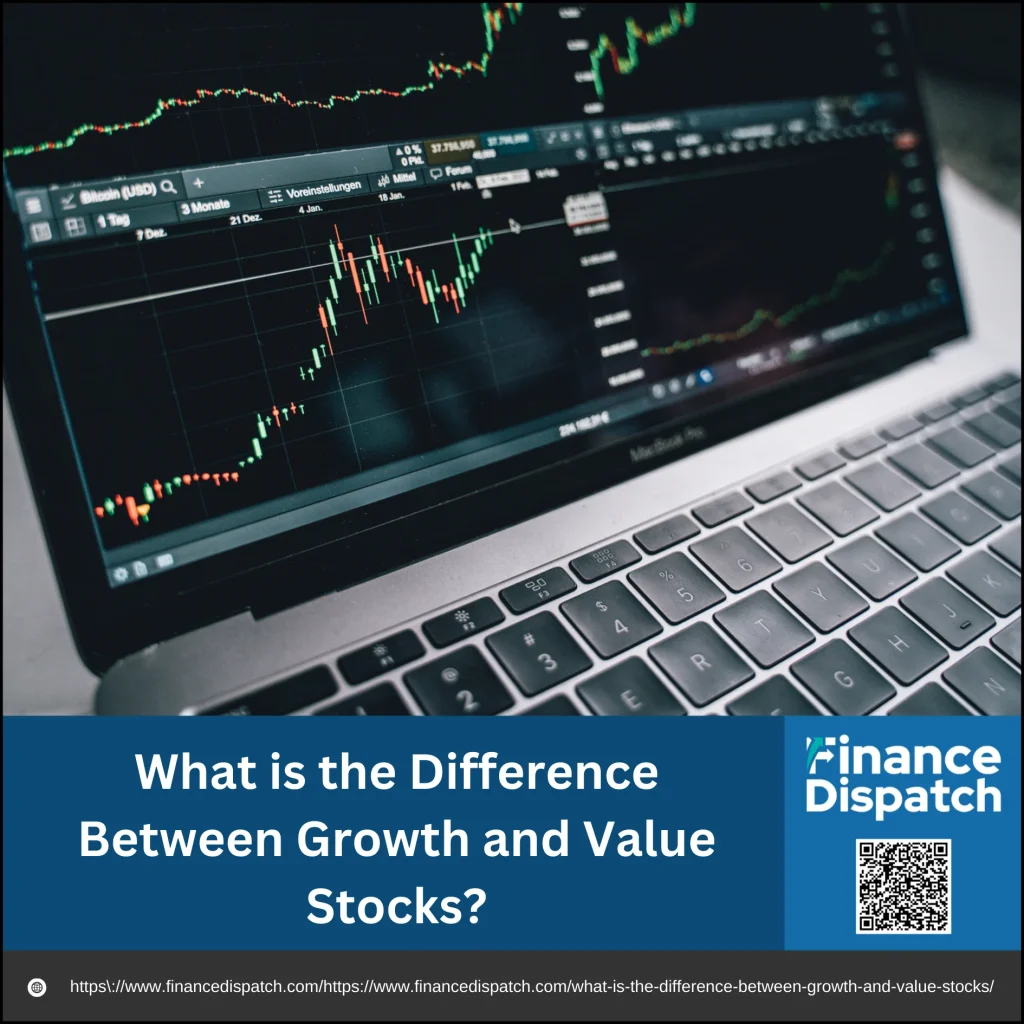When you start exploring the stock market, one of the first distinctions you’ll come across is between growth stocks and value stocks. These two categories represent very different investment approaches, each appealing to investors with unique goals and risk preferences. Growth stocks are linked to companies expected to expand rapidly, often reinvesting profits for future gains, while value stocks come from well-established companies trading below what analysts believe they’re truly worth. Understanding how these two styles differ isn’t just about definitions—it’s about recognizing how they perform under different market conditions, what kind of returns they may generate, and which approach aligns best with your own financial strategy.
What Are Growth Stocks?
Growth stocks are shares of companies that show strong potential to expand faster than the overall market. These businesses are often found in dynamic industries like technology, healthcare, or consumer innovation, where new products and ideas fuel rapid revenue increases. Instead of paying dividends, growth companies typically reinvest their earnings back into the business to accelerate expansion and maintain a competitive edge. This strategy can lead to substantial price appreciation for investors who are willing to take on higher risk in exchange for the possibility of larger long-term rewards.
What Are Value Stocks?
Value stocks are shares of companies that appear to be undervalued compared to their actual worth, often trading at lower price-to-earnings (P/E) or book value ratios. These companies are usually well-established, with stable earnings and a proven track record in industries like financials, energy, or consumer staples. Many value stocks also pay regular dividends, making them attractive to investors who prioritize steady income and lower risk. The idea is that, over time, the market will recognize the company’s true value, and its stock price will rise, rewarding patient investors.
Key Differences Between Growth and Value Stocks
While both growth and value stocks aim to build wealth, they do so in very different ways. Growth stocks focus on companies expected to expand rapidly, often with higher risk and reinvested profits instead of dividends. Value stocks, on the other hand, are tied to established companies trading below their intrinsic worth, offering more stability and often consistent dividend income. Understanding these contrasts helps investors decide which approach better suits their financial goals and risk tolerance.
Comparison Table
| Feature | Growth Stocks | Value Stocks |
| Pricing | Often priced higher than market average | Trade below intrinsic or book value |
| Earnings | High earnings growth expectations | Low P/E values, steady earnings |
| Risk/Volatility | Higher volatility, greater potential for losses | Lower volatility, relatively stable |
| Dividends | Rare or no dividends (profits reinvested) | Frequently pay dividends |
| Typical Sectors | Technology, biotech, consumer discretionary | Financials, energy, consumer staples, industrials |
| Investor Profile | Suited for risk-tolerant, future-oriented investors | Suited for conservative, income-seeking investors |
 Growth and Value Stocks Performance in Different Market Conditions
Growth and Value Stocks Performance in Different Market Conditions
The way growth and value stocks perform often depends on where the economy and financial markets are in their cycle. Growth stocks are generally more sensitive to optimism, low borrowing costs, and expanding industries, while value stocks tend to shine in periods of caution, economic recovery, or when investors prioritize income and stability.
How They Perform in Different Market Conditions
1. Bull Markets
In a strong economy, when markets are trending upward, growth stocks usually deliver higher returns. Investors are willing to pay more for companies with high earnings potential, expecting that rapid innovation or market expansion will lead to even higher future profits. Sectors like technology and consumer discretionary often lead this surge, with stock prices climbing rapidly as confidence grows.
2. Bear Markets
During downturns or recessions, value stocks typically perform better than growth stocks. Because they are usually tied to established businesses with strong fundamentals, they offer stability and, in many cases, dividends. While their prices may still decline, they don’t usually fall as sharply as high-risk growth stocks. This makes them a safer haven for investors seeking to minimize losses in uncertain times.
3. Rising Interest Rates
Value stocks tend to gain an advantage in periods of rising interest rates. Growth companies rely heavily on borrowing and reinvesting profits to fund expansion, and higher borrowing costs reduce their future profitability. Value stocks, often found in sectors like financials, energy, and consumer staples, are less affected by rising rates and may even benefit from them, making them more attractive to investors in these environments.
4. Low Interest Rates
Growth stocks thrive when borrowing costs are low because access to cheap capital supports business expansion, research, and innovation. Investors are more optimistic about future earnings when financing costs are minimal, pushing growth stock valuations higher. This environment particularly benefits tech and high-growth companies, as their forward-looking potential becomes even more appealing.
Historical Trends and Studies of Growth and Value Stocks
Looking at history, studies have shown that value investing has generally outperformed growth investing over the long term, especially when dividends are factored into returns. Going back as far as 1926, value stocks have experienced multiple periods of outperformance, offering investors steady gains and resilience during downturns. However, the story shifts when examining more recent decades. In the early 2000s, value stocks led the way, but in the last 10 years, growth stocks dominated, powered by technology companies and investor optimism around innovation. This alternating pattern highlights that neither strategy consistently wins across all timeframes, and performance often depends on broader economic cycles and market sentiment.
Examples of Growth and Value Stocks
Looking at actual companies helps clarify the difference between growth and value stocks. Growth stocks are typically linked to innovative firms that focus on expansion and reinvestment, while value stocks often come from established businesses that trade below their intrinsic worth and reward investors with stability and dividends.
Growth Stocks
1. Amazon (AMZN) – A global leader in e-commerce and cloud computing through AWS, consistently reinvesting profits into innovation and market expansion.
2. Tesla (TSLA) – Known for its rapid growth in electric vehicles and clean energy, Tesla represents the potential for high returns but also higher volatility.
3. NVIDIA (NVDA) – A pioneer in graphics processors and artificial intelligence, its fast-growing demand has driven strong price appreciation.
4. Meta Platforms (META) – Owner of Facebook, Instagram, and WhatsApp, relying on digital advertising and investing heavily in future technologies like the metaverse.
5. Netflix (NFLX) – Transformed global entertainment with streaming, growing rapidly as it expands its subscriber base and content offerings.
Value Stocks
1. JPMorgan Chase (JPM) – A leading U.S. bank offering stability, steady earnings, and regular dividends, making it a classic value play.
2. Berkshire Hathaway (BRK.A/BRK.B) – Warren Buffett’s diversified holding company, often viewed as undervalued relative to its assets.
3. Procter & Gamble (PG) – A consumer goods giant with household brands, offering consistent revenue and dividend income even in tough times.
4. Deere & Company (DE) – A trusted manufacturer of agricultural and industrial equipment, reflecting long-term stability in essential industries.
5. Cigna Group (CI) – A major healthcare and insurance provider, typically valued for steady cash flows and reliable dividend payments.
 Pros and Cons of Growth Stocks
Pros and Cons of Growth Stocks
Growth stocks often attract investors because of their potential to deliver big rewards. These companies are typically in industries with strong expansion opportunities, such as technology, healthcare innovation, or renewable energy. But while the upside is appealing, growth stocks also carry risks that can’t be overlooked. Here’s a closer look at both sides.
Pros of Growth Stocks
1. High Return Potential
Growth stocks can provide significant gains if the company’s revenue and earnings grow as projected. Investors often see substantial increases in stock prices over time, especially when companies continually innovate or expand into new markets.
2. Market Momentum
These stocks tend to thrive in bull markets, where overall optimism pushes prices higher. Because they are often linked to emerging industries, growth stocks can ride waves of investor enthusiasm, amplifying their upward momentum.
3. Innovation Advantage
Growth companies usually focus on creating new products, services, or technologies. This innovative edge can give them a competitive position in their industry, helping them capture market share and maintain strong growth trajectories.
Cons of Growth Stocks
1. High Volatility
Growth stocks often experience sharp price swings. While they can rise quickly, they can also fall just as fast if earnings reports disappoint or if market sentiment shifts. This volatility can be stressful for conservative investors.
2. No or Low Dividends
Unlike value stocks, most growth companies reinvest their profits into expansion projects rather than paying dividends. This means investors rely solely on the stock’s price appreciation for returns, with no steady income stream.
3. Overvaluation Risk
Because growth stocks are priced on future expectations, they can become overvalued. If a company fails to meet its projected growth or faces setbacks, its stock price can plummet, leaving investors with heavy losses.
Pros and Cons of Value Stocks
Value stocks often appeal to investors who prefer stability, dividends, and long-term potential over high short-term gains. They represent companies trading below their intrinsic worth, offering opportunities for steady returns when the market adjusts. Still, value investing is not risk-free, as some stocks remain undervalued for reasons that can hurt investors. Below is a closer look at both the advantages and drawbacks.
Pros of Value Stocks
1. Stability and Lower Volatility
Value stocks usually come from established companies with strong fundamentals and consistent earnings. These businesses often operate in industries that provide essential goods or services, such as banking, energy, or consumer staples. As a result, their stock prices don’t swing as wildly as growth stocks, giving investors more stability and predictability.
2. Dividend Income
Many value companies return a portion of their profits to shareholders through dividends. This provides investors with a steady income stream, even if the stock price doesn’t move significantly. For income-focused investors or those in retirement, this makes value stocks especially attractive.
3. Potential for Price Recovery
Because value stocks are considered undervalued, investors buy them with the expectation that the market will eventually recognize their true worth. When that happens, the stock price often rises, allowing investors to benefit from both dividend income and capital appreciation over time.
Cons of Value Stocks
1. Slower Growth
Unlike growth companies, value stocks usually do not experience rapid expansion. Their prices tend to rise gradually, which may not satisfy investors looking for quick gains. For those seeking aggressive portfolio growth, value stocks can feel underwhelming.
2. Value Traps
Sometimes a stock looks cheap but is undervalued for a valid reason—this is called a value trap. Problems such as poor management decisions, outdated products, or long-term decline in the industry can cause a stock to remain undervalued, limiting future returns or even leading to losses.
3. Extended Waiting Periods
Even fundamentally strong value stocks may take years for the market to properly revalue. This long waiting period can test investors’ patience, especially when other investments are performing better in the short term. Value investing, therefore, often requires a disciplined, long-term mindset.
Which One Should You Choose Growth and Value Stocks?
Deciding between growth and value stocks comes down to your personal investment goals, time horizon, and tolerance for risk. If you’re comfortable with higher volatility and want the chance for substantial long-term gains, growth stocks may be the right fit, especially during periods of economic expansion. On the other hand, if you prefer stability, steady dividend income, and lower risk, value stocks can offer more predictable returns and resilience during downturns. Many investors find that the most effective strategy is a balanced approach, combining both growth and value stocks in their portfolios to capture potential upside while reducing overall risk.
Conclusion
Understanding the difference between growth and value stocks is key to making smarter investment decisions. Growth stocks offer the allure of high returns through rapid expansion but carry higher risk and volatility, while value stocks provide stability, dividends, and the chance to profit when the market corrects undervaluations. Neither approach is universally better—the right choice depends on your financial goals, risk tolerance, and investment horizon. For many investors, blending both strategies in a diversified portfolio can strike the best balance, allowing them to benefit from growth opportunities while enjoying the steady reliability of value stocks.



